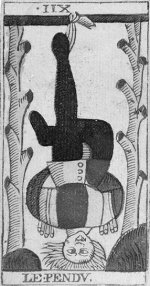jmd
In the recent thread titled The Hanged Man... death of a Jew in Christian lands?, Shalott draws attention to the 'epaulettes' as they are depicted on the Noblet, Payen and Dodal version of the cards, significantly (perhaps) omitted in the Chosson (& hence also the Conver that appeared nearly a century later).
A number of questions arise, including, of course, whether they are in fact epaulettes.
Personally, I do not see them as epaulettes at all, but rather as the fingers of the perhaps brutally tied Pendu, his elbows joined behind his back, forcing his forearms to dangle in uncharacteristic form, perhaps even broken.
One aspect of the image that further suggests that they are fingers is also the number dangling, and even the end showing what appears to be fingernails. The Noblet even shows what could easily be the thumbs!
For the sake of seeing the image, attached is the Payen.
A number of questions arise, including, of course, whether they are in fact epaulettes.
Personally, I do not see them as epaulettes at all, but rather as the fingers of the perhaps brutally tied Pendu, his elbows joined behind his back, forcing his forearms to dangle in uncharacteristic form, perhaps even broken.
One aspect of the image that further suggests that they are fingers is also the number dangling, and even the end showing what appears to be fingernails. The Noblet even shows what could easily be the thumbs!
For the sake of seeing the image, attached is the Payen.



